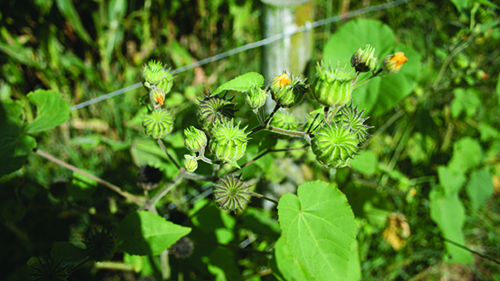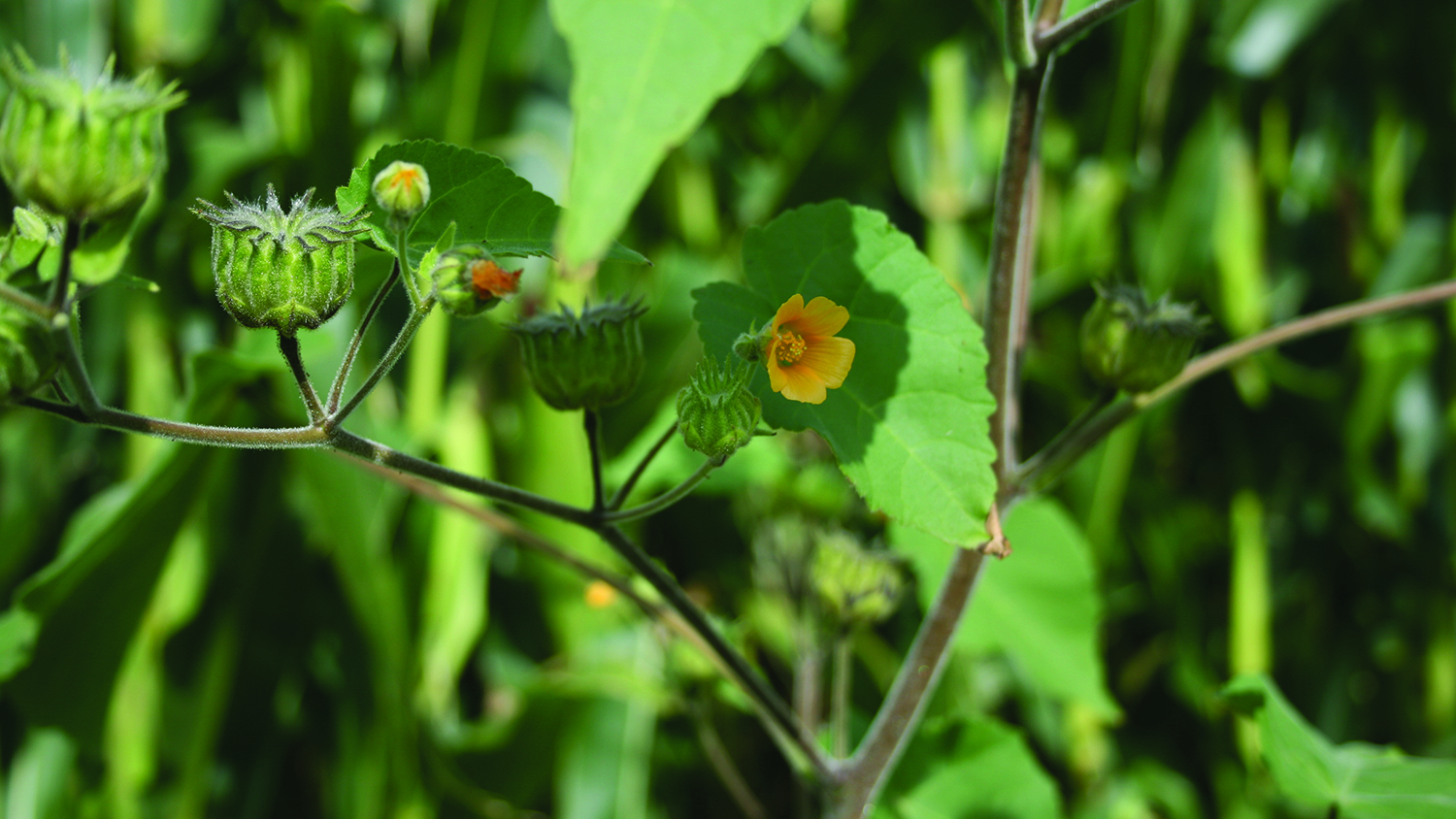| Management programme |
| Progressive containment |
| Objectives |
| Reduce the amount of velvetleaf and limit the locations that have it in the Waikato region. |
| Impacts |
| Economic |
Important message from Waikato Regional Council:
Velvetleaf is in the Waikato region. It is one of the world's worst cropping weeds and has spread to properties in the Waikato region via:
- unclean machinery
- infested maize crops, maize silage and maize grain.
One of the world’s most invasive pest plants, velvetleaf damages arable crops by competing with them for nutrients, space, and water. It is an unwanted organism under the Biosecurity Act and, as such, entry to New Zealand is prohibited.
More information is at: www.mpi.govt.nz/velvetleaf.

What does it look like?
Velvetleaf is an annual broadleaved herb that grows to between 0.5m and 2.5m tall.
Flowers
- Buttery-yellow flowers about 3cm across.
- Each flower is only open for a few hours.
- Flowers from spring through autumn.
Fruit/seeds
- Distinctive seed capsules with 12-15 woody, hairy segments in a cup-like ring.
- Each seed capsule is about 2.5cm in diameter.
- Segments remain intact at maturity, each releasing 1-3 seeds through an opening at the top.
Leaves/stems
- Leaves are large, heart-shaped, and velvety to the touch (hence the name).
- Crushed or bruised leaves give off an unpleasant smell.
Report sightings of velvetleaf
Farmers are encouraged to report suspected sightings of velvetleaf to biosecurity pest plant staff on 0800 800 401).
This will allow our staff to assess the property and then work with farmers on a plan if we confirm the presence of velvetleaf. Anyone who thinks they have found velvetleaf should:
- photograph any plants
- mark the location of plants so they can be found again easily.
Do you need support?
Famers requiring help to deal with the stress of the velvetleaf incursion are encouraged to call the Rural Support Trust on 0800 787 254 or contact them online.
Why is it a pest?
Velvetleaf is a serious cropping weed that can significantly reduce crop yields (by up to 70 per cent). Once established it is difficult to control; it is resistant to many herbicides, and normal weed management practices don’t control it. This is part due to its very long-lived seeds, that can remain dormant in the soil for up to 60 years if left undisturbed. Velvetleaf seedlings too are vigorous and new plants grow rapidly in the first few months after germination.
A member of the mallow family, velvetleaf is already present in New Zealand, including in the Waikato region. A national outbreak in 2016 was linked to imported fodder beet seed that was infested with velvetleaf.
However, Waikato incursions of velvetleaf have also been linked to the movement of infested maize crops and maize silage, unclean machinery, and stock that have eaten infested feed. The seed can survive in maize silage and in the gut of cattle, meaning it can potentially be spread rapidly through farms. Farm, crop and machinery hygiene are important strategies for the prevention and control of this problem pest.
Removing velvetleaf
There are strict protocols to assist with the safe removal of velvetleaf.
If seed heads have not formed:
- hand pull plants.
- spraying is an option where small seedlings are abundant.
If seed heads are present on the plant:
- carefully place a large bag over the seed capsules and flowers
- tie the bag tightly around the stem
- bend the stem in half
- pull out the plant and place in another bag.
If seed heads have blackened:
- place drop sheet on the ground, tightly against the stem to catch any falling seed
- carefully place a large bag over the seed capsules and secure tightly around the stem
- pick up and bag any seeds which have fallen onto the drop sheet
- check soil for fallen seeds or seed capsules. If seed has dropped, consider soil removal into a bag.
Contact Waikato Regional Council pest plant staff on 0800 800 401 for advice on disposal. Do not bury bags of velvetleaf on farm.
Control methods
If you suspect you have velvetleaf on your property, contact our pest plant staff on 0800 800 401. Waikato Regional Council staff will work with you to develop an individual biosecurity plan which will include long term
management options to control velvetleaf on your property and reduce the risk of spread.
Summary of herbicides and application methods for control
| Herbicide | Application |
| 2, 4-D | Spray application (broadcast) for pasture. |
| Aminopyralid/triclopyr | Spray application (spot-spray) for pasture. |
| Acetochlor plus saflufenacil | Spray application (pre-emergence) for maize. |
| Topramezone (Arietta ®), dicamba (e.g. KambaTM) or mesotrione |
Spray application (post-emergence) for maize. |
| Herbicide rules will apply. You may need to notify neighbours if spraying. The Waikato Regional Plan explains the agrichemical (herbicides) use rule in section 6.2, online at www.waikatoregion.govt.nz/regionalplan. | |
Tips – stopping the spread :
Velvetleaf can spread by soil movement, stock feed and equipment such as diggers, crop harvesting machinery and farm machinery. Take special care not to transport it to new sites. Farmers should protect their properties from velvetleaf and other serious plant pests by:
- insisting all contractors practice good weed hygiene, cleaning their equipment before entering the farm
- ensuring supplementary feed brought onto the farm is weed free
- ensuring manures, aggregates, soil and sand brought onto the farm are weed free
- checking feed crops before purchase to ensure they are weed free.
Restricted places
More information
Advice
- For advice and additional information on velvetleaf, call our pest plant staff on freephone 0800 800 401.
- Chemical company representatives, farm supply stores, garden centres or the Weedbusters website can also be good sources for advice.
Publications
The following publications are available for download or from Waikato Regional Council. Contact us to request a copy (freephone 0800 800 401).
-
Factsheet - Velvetleaf
1.6 MB
-
There's velvetleaf on my farm - information for farmers
1.6 MB
-
Keep it clean: Machinery hygiene guidelines and logbook
3.4 MB
-
National Pest Plant Accord (Manual of plants banned from sale, propagation and distribution)
Ext. link
-
Plant Me Instead! (Plants to use in place of pest plants)
Ext. link






To ask for help or report a problem, contact us
Tell us how we can improve the information on this page. (optional)